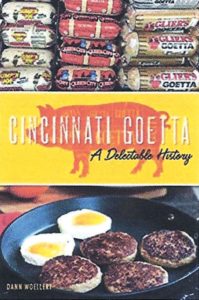 Editor’s Note: Colleen Phillips, a writer for The Tracer, a publication produced by the Hamilton County Chapter of the Ohio Genealogical Society, provided this Book Review about Goetta. I found it fascinating and it helped me understand how this food item came to be. I thought you might enjoy knowing about it, too. P.D.
Editor’s Note: Colleen Phillips, a writer for The Tracer, a publication produced by the Hamilton County Chapter of the Ohio Genealogical Society, provided this Book Review about Goetta. I found it fascinating and it helped me understand how this food item came to be. I thought you might enjoy knowing about it, too. P.D.
BOOK REVIEW by Colleen Phillips
There is no denying food historian Dann Woellert’s passion for German gruetzwurst (grain sausage), aka goetta, in his latest book Cincinnati Goetta: A Delectable History. A man with a mission, he wanted to dish up goetta’s story and trace its roots back to Germany. While he was able to determine the sausage originated in the farming regions of the northwestern German states of Westphalia, Lower Saxony, and Schleswig-Holstein, its exact birthplace eluded him.
Versions of the recipe came to America with the German hausfraus who ultimately settled in Cincinnati’s Over-the-Rhine and Covington, Kentucky’s German neighborhoods. Their new home’s thriving meat packing industry provided better cuts of meat than what was available back in the old country. Despite its humble beginnings and thanks in part to the annual Goettafest and commercial suppliers, goetta has become a diet staple in the Queen City (Cincinnati).
This is not just the story of goetta but the people behind it as well. The author introduces readers to German-born Johann Christian Dorsel, founder of the Dorsel Flour Company. His mill in Newport supplied pinhead oats, a crucial component in any goetta recipe. It’s the oatmeal that gives goetta that snap, crackle and pop if fried at too high a temperature, according to the author. Of course, no history of sausage making would be complete without mentioning the meat packing firms like Kahn’s, Kluener Meats, Lohrey Packing, and H.H. Meyer that provided the pork and beef.
Dann Woellert is an excellent storyteller. He successfully blends family, community and business histories as he spotlights local sausage makers from both sides of the Ohio River who jumped onto the goetta bandwagon. While many local butcher shops offer their own versions of goetta and receive mention, the book focuses on the big three – Queen City Sausage, Finke and Sons, and Glier’s Meats.
Elmer Hensler has been in the meat business since the age of eleven. He learned his trade while working for Ernie Eckerlin (Eckerlin’s Best Goetta at Findley Market) and opened Queen City Sausage in 1965. Now in his late 80s, he still oversees the production of about 5,000 pounds of goetta per day. Queen City Sausage is Cincinnati’s largest goetta producer.
Covington’s Mainstrasse and Mutte Gottes neighborhood was home to George (aka Johann Gerhard) and Louise Finke. In 1876, George opened a butcher shop and Louise supplied the recipe for their version of grain sausage. The Finkes are credited with being the first to mass produce goetta. Today, Finke and Sons still use the same recipe handed down from generation to generation. George Finke Jr., was even able to sell this traditionally German food to Irish customers on his meat-wagon route by renaming it “Irish Mush.”
In Covington, Bob Glier broke with family tradition, choosing to make goetta instead of violins. But he didn’t care for his mother’s porridge-like goetta and perfected his own recipe. In 1946 he opened a butcher shop in Covington and began selling his version of guetta (pronounced gutta or gudda), one of many spellings for the product. Historically, the sausage contained the unappetizing scraps that were left after the butchering process. To dispel any concerns about what animal parts went into their guetta, company president Dan Glier (Bob’s son) Americanized both the spelling and pronunciation of their goetta (getta).
The author also shares his adventures on Ohio’s Goetta-Grits-Prettles Trail that follows the path of the Miami and Erie Canal. Each stop along the way offered a different sausage specialty reflecting that area’s distinct German heritage. The same can be said for goetta’s regional cousins like Pennsylvanian scrapple, Louisiana boudin and Texas jitrnice (Czech sausage). All dishes can be traced back to immigrants who came from regions in Germany.
Like Dann Woellert’s earlier books, his latest is well written and thoroughly researched. Readers will even find several recipes for goetta as well as a family tree of sorts for the sausage, detailing its evolution as well as its collateral lines. Readers will have a deeper appreciation for not only this cultural delicacy but the immigrants who brought it to this country and those who preserved its heritage.















Follow Us